Japanese bonsai tree: growing and forming the crown
Bonsai - this is an extraordinary art of growing dwarf trees of the most bizarre forms at home. Bonsai has long been a part of Japanese culture. In Japan, you can find museums and gardens dedicated to the cultivation of bonsai. It is believed that each such plant has spiritual value, so their cost can be very high. You can grow a bonsai tree yourself at home if you know the basics of this art and spare no time and effort.
Content:
- What is it, features and types
- Which plants are suitable for bonsai?
- Planting: the choice of soil and capacity
- Growing conditions
- Crown formation and bonsai styles
What is it, features and types
The word "bonsai" means "a plant in a flat vessel." Under this concept, the name of both a bonsai and the whole art of growing it can be hidden. It appeared in the 9th century in Japan. Now there is a whole museum where you can see various types and species of dwarf trees.
The Japanese bonsai tree requires constant maintenance.
It continues to grow for many years, so it will have to be constantly shaped, trimmed and made sure that the composition remains beautiful and alive. This hobby is not for the lazy. The main feature of bonsai is that there are no special seeds for bonsai trees. All these are ordinary, familiar to us trees, which are grown in a special way that does not allow the plant itself to grow strongly.
There are several classifications of bonsai:
- By plant size. The largest bonsai tree can reach 120 cm, and the smallest - up to 5 cm.The average size of a bonsai tree is from 15 to 60 cm.However, this art is not only about preventing the tree from growing, it must be aesthetic, have a fancy shape.
- According to the characteristics of growth and flowering. Evergreens, trees that can shed their foliage in autumn, trees blooming at different times are distinguished. The choice depends only on the preferences of the owner. However, it is necessary to take into account the period of growth and flowering of the plant in order to properly care for it and feed it on time.
- By wood species. For growing bonsai trees, a wide variety of species are chosen: Garnet, acacia, sakura, Pine, thuja, Birch tree etc. These breeds differ not only in appearance, but also in the characteristics of their care.
- According to the style of crown formation. There are many styles of bonsai, but a beginner will have to master some crown shaping techniques to get it beautifully. The most difficult one can be called the “tree on stone” style, since you will have to fight for the growth and beauty of such a plant.
A person who creates a bonsai tree takes care of it, puts part of his soul and energy into it. For this reason, it will not be possible to purchase such a tree cheaply. There are collectible bonsai trees in Japan that cost a lot of money.
Which plants are suitable for bonsai?
The choice of trees for the bonsai technique is practically unlimited. However, experts say that it is not recommended to choose tall and large trees and force them to grow dwarf ones.
When choosing a tree, one must take into account not only its type and breed, but also a combination of external signs: height, crown, size of leaves and inflorescences, if any, thickness of the trunk, etc. For home growing, exotic plants are also suitable, if you find the right approach to them.
Very often conifers are chosen as a bonsai tree.
They are quite hardy, durable, look beautiful. The most popular bonsai tree species are:
- Juniper... For bonsai, Cossack juniper is most often used. The popularity of this plant is based on its unpretentiousness and beauty. In its natural environment, it grows like a shrub, but at home it can be easily formed in the bonsai style. You can also often find a bluish Chinese juniper. This plant is also quite hardy and can even tolerate frost.
- Sakura. A bonsai-style cherry tree looks very beautiful, especially during its lush bloom. There are many varieties of this tree and almost all of them are suitable for growing in the bonsai style. A feature of the Japanese cherry is the delicate light pink flowers that completely cover the tree during the flowering period.
- Pine... The most popular with bonsai fans is the white Japanese pine. However, domesticating such a plant will not be easy, since pines grow best outdoors. They need fresh air and a change in temperature.
- Cedar... As you know, Japanese cedar can reach enormous heights in natural conditions. Small cedars look very unusual. For those who often flood plants, cedar is perfect. He loves moisture and even tolerates an excess of it well.
For beginners who are just trying their hand at the art of bonsai, it is recommended to choose ficuses... This plant itself is medium-sized and perfectly imitates a bonsai.
Planting: the choice of soil and capacity
Bonsai tree seeds can be purchased at specialty stores or botanical gardens. Many people think that it is almost impossible to grow a tree from a seed, as it takes too long, but with proper seed preparation, this process will not seem long.
It is worth remembering that the seeds do not have the properties of dwarf plants, that is, the seed itself will not help to immediately get bonsai. The tree must be planted and grown correctly so that it forms beautifully and does not grow larger than the required size.
The planting process has several features:
- Seeds need to be sown depending on the species and type of tree. Some seeds require stratification, otherwise they will take a very long time to sprout (juniper, maple, quince). Seeds keep well in a cool place. Sometimes the seeds require a dormant period. They are left in wet sand and kept cool. So they can be stored for up to a year.
- Do not sow purchased seeds right away. Their beginning needs to be prepared and processed. In order for the seeds to germinate, they are placed in clean water for several days and kept so until the sprouts hatch. If the seeds have a dense hard shell, it must be broken.
- You can plant seeds in the ground in spring or early autumn. For the first planting, it is better to prepare peat cups, which are filled with sand and peat in equal proportions. In order not to make the mixture yourself, you can buy cactus soil from the store and add sand to it.
- It is not necessary to fill the glass completely with the mixture. Usually about 3 cm is left from the edge. The soil needs to be slightly compacted, put seeds on top and sprinkle with a thin layer of sand to make it easier for them to hatch.
- The bonsai tree container should be flat, like a tray. Pots can be ceramic, clay, glass. It is imperative to use drainage. The size of the pot must match the size of the root system, otherwise the tree may die.
The result largely depends on the correct planting, so you should not neglect the rules for planting bonsai.
Growing conditions
All bonsai techniques can be divided into 3 important steps: seed selection and preparation, sprout care, and mature tree care. To make a tree really beautiful and unusual, you need to constantly take care of it. For many, the technique of growing bonsai is too complicated.
Each of these steps can take a long time. For some trees, even caring for a seed takes years. Sprout care requires constant attention. Creating optimal conditions is an integral part of growing a bonsai tree.
Even if you choose the most unpretentious wood species, you will still need maximum care. Growing a bonsai tree includes:
- Accommodation. Some bonsai trees can tolerate frost, so they can be grown outdoors. The correct position of the plant is very important for its further growth. The place for the tree should be well lit. Do not put the plant close to the battery.
- Correct lighting... As with any plant, a bonsai tree needs ample amount of light. If there is little sunlight, artificial lighting can be created. In winter, some plants enter a dormant period, so the amount of light and watering is reduced.
- Watering... Watering requires a special approach, since the capacity is small and the amount of soil is also small. The frequency of watering depends on the breed and plant variety. Some trees do not like moisture and get sick from excess liquid, while others cannot stand drought. The water temperature should be medium, room temperature.
- Top dressing. It is enough to feed the tree for successful growth and flowering once every 10 days. The choice of fertilizer depends on the type of tree. Can be used organic and inorganic fertilizers.
The main secret of bonsai is that the tree is selected the optimal size of the pot. It is in it that the process of further cultivation will take place. To balance the root system and the ground part, the tree must be constantly pruned and trimmed to form a crown.
Crown formation and bonsai styles
The art of bonsai has evolved over the years, and during this time, a huge number of styles of tree creation have emerged. Of course, first of all, bonsai is created for the sake of decorativeness. The main role is played by the shape of the trunk and crown. It is they who create that unique appearance of the bonsai, which is so appreciated all over the world.
The most common bonsai styles are:
- Hokidachi. This is the style of creating a crown like a fan. Great for trees with thin and small leaves. The trunk of the tree should be straight, not curly. This crown resembles a ball and looks very beautiful at any time of the year.
- Moyogi. This style is also found in the natural environment. The tree trunk is curved and resembles the letter "s". Each bend has its own leafy branches. Branches and leaves begin about a third above the base of the trunk. In this case, the base should be wider than the top.
- Bunzings. This is a bohemian style that aims to show the struggle of trees for survival. In their natural environment, such trees can be seen in dense forests where there is little light and only very tall trees survive, which can reach the illuminated area. The trunk of such a tree should be long, slightly curved and bare. Foliage is located only at the very top.
- Fukinagashi. It is also fighting style and survival. The tree trunk is curved and slightly tilted to the side. All branches are located on only one side of the tree. Such trees can be seen in places with strong winds that constantly blow in one direction.
Despite the presence of long-established styles, it is not necessary to follow any rules. The crown of a tree can have a completely bizarre and unusual shape that does not fit any style. Bonsai - this is, first of all, a manifestation of your imagination and creative impulses.
More information can be found in the video:




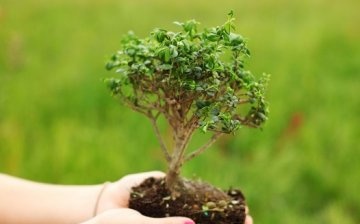
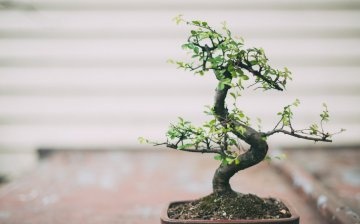

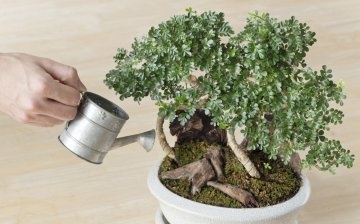
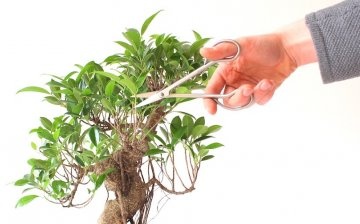







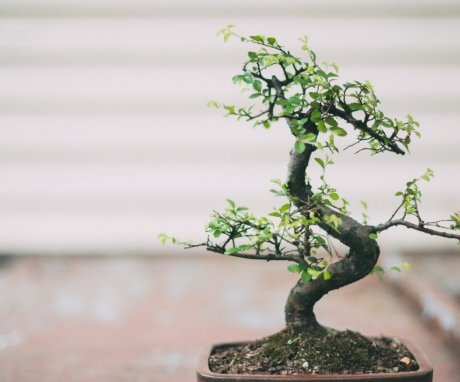

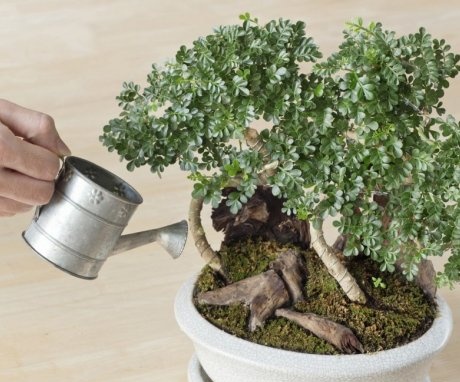
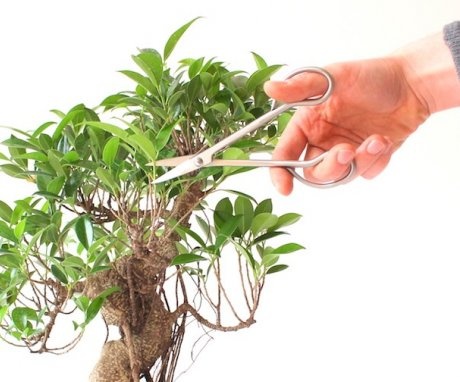
For me, bonsai turned out to be quite difficult to care for. Especially crown formation. Obviously, the conditions for the tree in my house were not suitable and I also found mistakes in care after reading the article.
We also could not grow AnnaAlimova, although we read a lot of literature. In the end, we gave up this venture and grow other flowers on the windowsill. I like cacti. Do you like them?